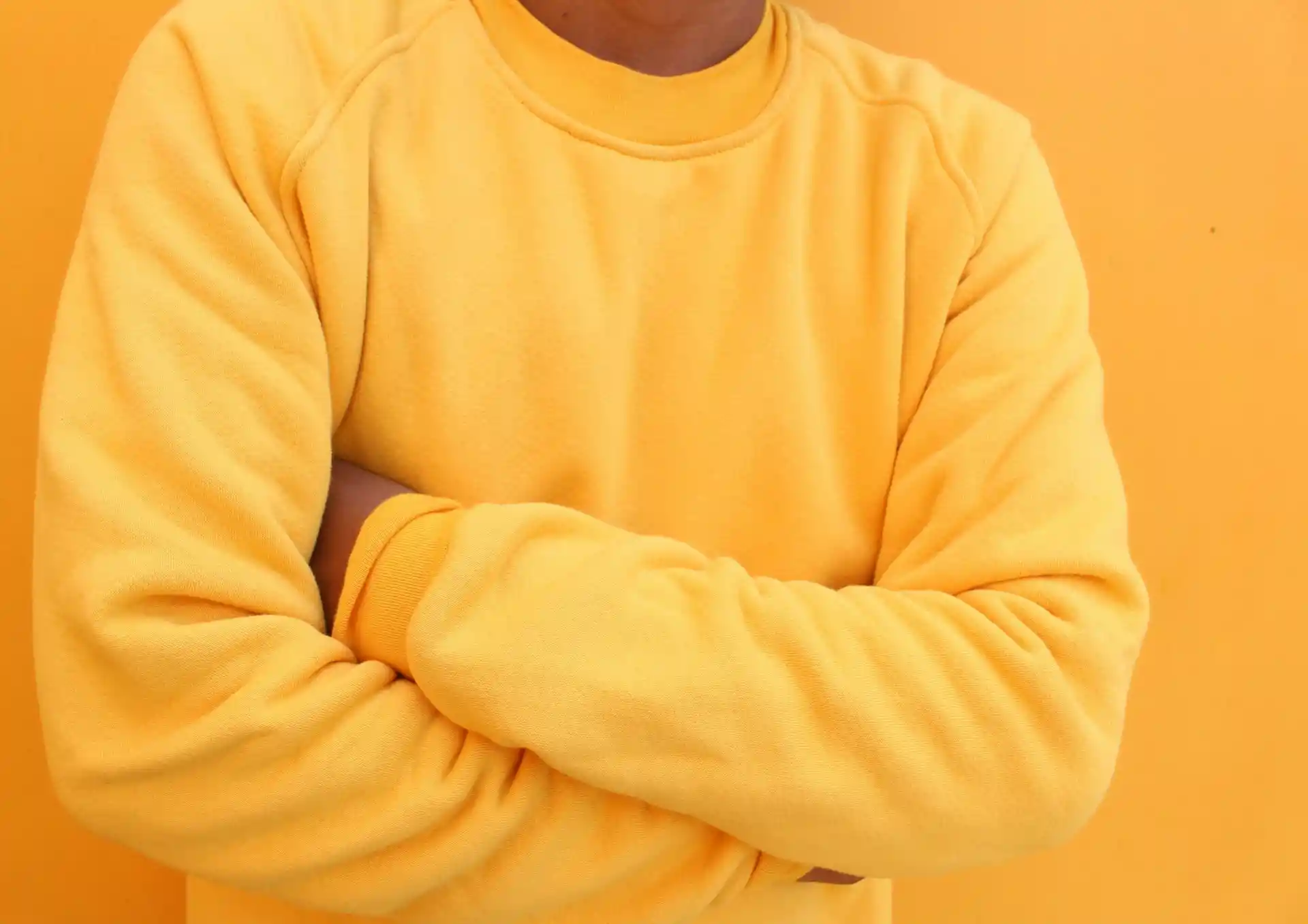
When it comes to choosing the perfect sweatshirt, understanding the differences between materials can make all the difference in comfort, style, and durability.
In this guide, we'll explore cotton vs polyester sweatshirt, breaking down the pros and cons of each fabric so you can make an informed decision.
Whether you prioritize softness, warmth, breathability, or easy maintenance, this comparison will help you choose the right sweatshirt for your lifestyle.
Understanding Cotton and Polyester Sweatshirt
Cotton Sweatshirt
You might already own a cotton sweatshirt—it's made from natural fibers that come from the cotton plant.
These fibers work by soaking up sweat from your skin, which keeps you feeling dry and cool during workouts.
Cotton feels soft against your body because its threads are fluffy and flexible. But remember, it can shrink if you wash it in hot water, as the fibers tighten up when heated.
Polyester Sweatshirt
A polyester sweatshirt uses synthetic material created from oil-based chemicals. It stays strong over time because the long plastic-like chains in the fabric resist breaking.
You get quick drying since it pushes moisture away instead of holding it. Polyester holds its shape well, even after many washes, thanks to its stretchy and tough structure.
Cotton vs Polyester Sweatshirt: Pros & Cons
Cotton Sweatshirt
Pros:
- Soft and comfortable: Cotton feels gentle on your skin, so it's easier to wear for long periods without irritation.
- Breathable: Air flows through the fabric, which helps when you're layering or moving around.
- Absorbs sweat: Cotton can handle light sweat, making it more comfortable if you're running errands or going for a short walk.
- Natural material: If you prefer eco-friendly options, cotton breaks down naturally and has less chemical processing.
Cons:
- Shrinks and stretches: Washing in hot water or drying on high heat can change the size.
- Wrinkles easily: It can look messy if left folded or packed in a bag.
- Dries slowly: After a wash, it can take a day or more to dry completely.
- Shows wear: Pilling or fading can happen faster, especially with frequent washing.
Polyester Sweatshirt
Pros:
- Durable and shape-retaining: It keeps its size and doesn't stretch out as easily.
- Quick-drying: Good for days when you need it ready after washing.
- Keeps color: It resists fading even if you wash it often.
- Lightweight warmth: Some polyester blends trap heat without feeling heavy, which is practical for workouts or layering.
Cons:
- Less breathable: Polyester can feel hot if you're active or in warm weather.
- Can hold odor: Sweat may linger, so regular washing is needed.
- Texture varies: Not all polyester feels soft; some can be rough at first.
- Synthetic material: It's not biodegradable, which might matter if you care about sustainability.

Custom Unisex Crewneck Sweatshirt (Made in USA) Customized Services - Print-On-Demand - PrintKK
Cotton vs Polyester Sweatshirt: Full Comparison
1. Comfort
Cotton Sweatshirt
A cotton sweatshirt feels soft and natural on your skin. It lets air pass through, which keeps you cooler when it's warm.
The fabric stretches slightly with your movements, giving freedom and comfort. You can wear it for long periods without feeling restricted, and it doesn't irritate sensitive skin.
It's a great choice for relaxed, everyday wear.
Polyester Sweatshirt
A polyester sweatshirt is smooth and lightweight, but it is less breathable than cotton. It holds its shape well and doesn't shrink easily after washing.
Because the fabric traps more heat, you may feel warmer during heavy activity. It works well for layering, and you can count on it to keep its appearance even after many washes.
2. Durability
Cotton Sweatshirt
Cotton fibers are gentle and soft, but they wear out faster over time. Your sweatshirt may fade in color, develop thin spots, or even small holes after frequent washing.
You need to handle it carefully and follow washing instructions to maintain its look. Despite this, cotton still lasts well with proper care.
Polyester Sweatshirt
A polyester sweatshirt is very strong and resists wear. It maintains its shape and color even after repeated washing.
The fabric doesn't tear or fade easily, making it ideal if you plan to wear it often.
Polyester withstands rough use better than cotton, so it's a practical choice for active lifestyles or frequent casual wear.
3. Warmth
Cotton Sweatshirt
Cotton sweatshirts provide moderate warmth. They trap some heat close to your body, keeping you comfortable in mild cold.
However, in very low temperatures, cotton may feel insufficient on its own. You might need to layer it with other clothing or wear it indoors for the best comfort.
Polyester Sweatshirt
Polyester sweatshirts trap heat more effectively because the synthetic fibers don't let air escape easily.
This makes them feel warmer in cold weather. They are good for outdoor use or for layering in winter.
However, if you sweat, the heat may feel intense since polyester does not absorb moisture like cotton.

4. Moisture Management
Cotton Sweatshirt
Cotton absorbs moisture very well, which can be a drawback during heavy activity.
When you sweat, it can feel damp and heavier on your body.
It dries slowly, so prolonged use in hot conditions may be uncomfortable. Cotton is best for casual wear or light activity where comfort matters more than moisture control.
Polyester Sweatshirt
Polyester sweatshirts dry quickly and keep you comfortable during movement.
The fabric wicks sweat away from your skin, keeping it light even if you are active. You will notice less sticking and dampness compared to cotton.
It's ideal for workouts, sports, or days when you might get warm while wearing it.
5. Maintenance
Cotton Sweatshirt
Cotton requires more care. It can shrink or wrinkle if washed or dried at high temperatures. You may need to iron it to keep a smooth appearance.
Following washing instructions carefully ensures that the sweatshirt lasts longer and retains its original softness. Improper care can make it look worn out faster.
Polyester Sweatshirt
Polyester is very low maintenance. You can machine wash and dry it without much worry.
It resists shrinking and wrinkling, so it keeps its shape and looks neat even with minimal effort. This makes it convenient if you want a sweatshirt that is ready to wear right out of the dryer.
6. Cost
Cotton Sweatshirt
Cotton sweatshirts are often more expensive because natural fibers cost more to produce.
You pay for softness and comfort, which makes it feel premium.
The price reflects the quality and natural feel of the material, but you may need to handle it carefully to protect your investment.
Polyester Sweatshirt
Polyester sweatshirts are usually cheaper.
The synthetic material is easier and faster to make in large amounts. You get durability at a lower price.
While polyester may feel less soft than cotton, it is practical for everyday wear or for situations where you need a long-lasting, low-maintenance option.

Custom AOP Raglan Crewneck Sweatshirts Women with Print on Demand - PrintKK
Cotton vs Polyester: Which to Choose for Every Situation
Daily Casual Wear
If you spend most of your day at home or running light errands, cotton sweatshirts are usually the better choice.
They feel soft against your skin and let air circulate, keeping you comfortable. You don't have to worry about looking stiff, and the fabric moves with you. Cotton works well when comfort matters more than durability.
Outdoor Activities
When you're hiking, jogging, or doing outdoor chores, a polyester sweatshirt can make a difference.
It dries quickly if you sweat and keeps its shape even after stretching. Polyester also resists stains and holds up better if you brush against rough surfaces. It won't sag or shrink in the sun as cotton might.
Travel and Packing
For long trips or backpacking, polyester is usually easier. It's lightweight, dries fast, and doesn't wrinkle much in a bag.
You can wear it multiple times without it looking worn. Cotton, by contrast, can feel heavy when wet and takes longer to dry, so it's less practical if you need flexibility in your wardrobe.
Layering in Cold Weather
If you plan to layer sweatshirts under jackets in winter, cotton can feel more natural and soft next to your skin.
It traps some warmth while still breathing, which prevents you from overheating indoors. Polyester layers work too, but they may feel slick or clingy against other fabrics.
Gym or Workout
For exercise, polyester generally outperforms cotton. It wicks away sweat, dries fast, and keeps you lighter during activity.
Cotton absorbs moisture, which can leave you damp and heavy. If your main focus is performance and ease of movement, polyester will stay functional even after repeated workouts.
Read More:
- Polyester vs Cotton Shirts: Which Is Better T-Shirt Fabric?
- Polyester Hoodie vs Cotton Hoodie: Choosing the Right Fabric
5 Other Sweatshirt Fabrics You Should Know About
Cotton Blends
These sweatshirts mix cotton with polyester or spandex, usually 60%-80% cotton.
They are durable, wrinkle-resistant, and shrink less than pure cotton.
The fabric is less breathable, and high synthetic content can cause static or irritation on sensitive skin. Good if you wash often or want a structured look.
Cotton Fleece
This has a soft looped interior and smooth exterior, giving it warmth and stretch.
It's thicker and classic, but heavier and less breathable, so it may feel stuffy if you sweat. Ideal for autumn and winter basics, and it can help hide extra weight.
Polyester Fleece
Made entirely of polyester, it feels like lambswool, lightweight, soft, and warm.
It dries fast but holds static and dust, and can look bulky. Best for cold weather outer layers if warmth matters more than fit.

Brushed Fleece
The inside is brushed into fine fibers for warmth while staying light and close-fitting. It works well as an inner layer, but can pill or snag, and loses warmth after many washes.
Dralon
A patented mix of acrylic, spandex, and polyester, Dralon is thin, warm, and moisture-wicking. It's great for base layers but watch out—some brands mislabel fabrics as Dralon®, so check for certification.
6 Details to Check Before You Buy Sweatshirt
1. Neckline
The neckline changes how a sweatshirt fits and how your upper body looks.
- Large neckline: Shows more shoulder and neck. It can make your upper body look slimmer and your posture appear relaxed.
- Small neckline: Feels tighter and can make your upper body look wider.
- V-neck: Makes your neck look longer and more defined, which can improve the overall balance of your outfit.
2. Shoulder Line
The shoulder design affects both comfort and how the sweatshirt sits.
- No shoulder seam: Works well if your shoulders are broad, letting the fabric fall smoothly.
- Raglan or angled shoulder: Helps the shoulders appear narrower, giving a cleaner silhouette.
- Small drop shoulder: Places the seam above the chest, which can make arms look bulkier and change the fit across the chest.
3. Hood
The hood affects both style and how the sweatshirt feels around your head.
- Small hood: Piles around the neck and can feel bulky. It may also make the head look larger.
- Large hood: Leaves space around the neck, so it feels lighter and your head looks smaller. The drape can also change the overall shape of the sweatshirt.
4. Cuffs
Cuffs keep the sleeves in place and influence how tidy the sweatshirt looks.
- High-density ribbed cuffs: Usually thicker than 2cm. They hold their shape, prevent sleeves from stretching, and give structure without limiting movement.
5. Weight
The weight determines how you can wear the sweatshirt and how warm it feels.
- Under 300g: Light enough for layering, works well under jackets.
- 320g–400g: A balanced weight. You can wear it alone or layer it, depending on the weather.
- Over 400g: Thick and warm, suitable for wearing by itself. It keeps its shape and provides more insulation.
6. Neckline Stitching
Neckline stitching affects durability and how the sweatshirt looks over time.
- Three-needle stitch: Strong and detailed, holds the neckline well.
- Two-needle stitch: Simple but sturdy, keeps shape longer than a single stitch.
- One-needle stitch: Less durable, more likely to stretch or lose shape after washing. Checking this can save you from early wear and tear.
Expert Tips
Choosing between a cotton vs polyester sweatshirt comes down to what you need day to day. Cotton gives you softness and breathability, which works well if comfort is your priority.
Polyester stands up to wear, dries fast, and keeps its shape, which is handy for more active use. Look at the fit, fabric weight, and stitching details.
Knowing these differences helps you pick a sweatshirt that suits your lifestyle. The right choice keeps you comfortable, makes layering easier, and ensures your sweatshirt lasts longer.










 Global Shipping
Global Shipping





























